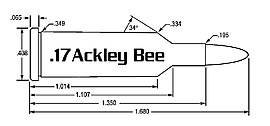This article has multiple issues. Please help improve it or discuss these issues on the talk page. (Learn how and when to remove these template messages)
This article needs additional citations for verification. Please help improve this article by adding citations to reliable sources. Unsourced material may be challenged and removed.Find sources: ".17 Ackley Bee" – news · newspapers · books · scholar · JSTOR (January 2013) (Learn how and when to remove this message)
The topic of this article may not meet Wikipedia's notability guidelines for products and services. Please help to demonstrate the notability of the topic by citing reliable secondary sources that are independent of the topic and provide significant coverage of it beyond a mere trivial mention. If notability cannot be shown, the article is likely to be merged, redirected, or deleted.Find sources: ".17 Ackley Bee" – news · newspapers · books · scholar · JSTOR (February 2023) (Learn how and when to remove this message)
(Learn how and when to remove this message)
| .17 Ackley Bee | ||||||||||||
|---|---|---|---|---|---|---|---|---|---|---|---|---|
 | ||||||||||||
| Type | Rifle | |||||||||||
| Place of origin | United States | |||||||||||
| Production history | ||||||||||||
| Designer | P.O. Ackley | |||||||||||
| Designed | 1940s | |||||||||||
| Specifications | ||||||||||||
| Parent case | .218 Bee | |||||||||||
| Case type | Rimmed, bottleneck | |||||||||||
| Bullet diameter | 0.172 in (4.4 mm) | |||||||||||
| Neck diameter | 0.195 in (5.0 mm) | |||||||||||
| Shoulder diameter | 0.334 in (8.5 mm) | |||||||||||
| Base diameter | 0.349 in (8.9 mm) | |||||||||||
| Rim diameter | 0.408 in (10.4 mm) | |||||||||||
| Rim thickness | .065 in (1.7 mm) | |||||||||||
| Case length | 1.35 in (34 mm) | |||||||||||
| Case capacity | 16.89 gr H2O (1.094 cm3) | |||||||||||
| Rifling twist | 1-12 inches | |||||||||||
| Primer type | Small rifle [1] | |||||||||||
| Ballistic performance | ||||||||||||
| ||||||||||||
| Source(s): Reload Bench [2] | ||||||||||||
The .17 Ackley Bee is a wildcat centerfire rifle cartridge named after its designer, P.O. Ackley, and is a .218 Bee case necked down to .17 caliber with a squarer shoulder and less body taper. Being a rimmed case it was popular in single shot rifles such as the Martini Cadet and Low Wall Winchester.[2] The caliber is well suited to varmint hunting particularly where minimal pelt damage is required.[citation needed]
